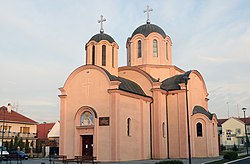Novi Banovci: Difference between revisions
No edit summary |
|||
| Line 71: | Line 71: | ||
==History== |
==History== |
||
Following the Roman conquest in the 1st century BC, the settlement was known as '''Burgenae'''.<ref>{{Cite web|url=https://turizampazova.rs/arheoloski-lokaliteti/|title=Arheološki lokaliteti Istorijat {{!}} Turistička organizacija opštine Stara Pazova|language=sr-RS|access-date=2020-03-30}}</ref> <!-- An important fortification (500 x 600 m), the residence of ''Cohors I Thracum civium Romanorum'', civil settlement, necropolis has been excavated. In late antiquity, according to Notitia, ''cuneus equitum Constantianarum'', a part of [[Legio V Iovia]] as well as ''equites Dalmatae'' were stationed here.<ref>http://old.perseus.tufts.edu/cgi-bin/ptext?doc=Perseus:text:1999.04.0006&query=id%3D%231514</ref> --> |
Following the Roman conquest in the 1st century BC, the settlement was known as '''Burgenae'''.<ref>{{Cite web|url=https://turizampazova.rs/arheoloski-lokaliteti/|title=Arheološki lokaliteti Istorijat {{!}} Turistička organizacija opštine Stara Pazova|language=sr-RS|access-date=2020-03-30}}</ref> <!-- An important fortification (500 x 600 m), the residence of ''Cohors I Thracum civium Romanorum'', civil settlement, necropolis has been excavated. In late antiquity, according to Notitia, ''cuneus equitum Constantianarum'', a part of [[Legio V Iovia]] as well as ''equites Dalmatae'' were stationed here.<ref>http://old.perseus.tufts.edu/cgi-bin/ptext?doc=Perseus:text:1999.04.0006&query=id%3D%231514 {{Dead link|date=March 2022}}</ref> --> |
||
Novi Banovci experienced a constant population growth in the 20th century. A significant increase in the neighborhood's population occurred in the mid-1990s, caused by the large influx of refugees from the [[Yugoslav War]], especially after the [[Operation Storm|Oluja military action]] which forced almost 250,000 Serbs from [[Croatia]] into Serbia, and many of them settled at the outskirts of Belgrade. |
Novi Banovci experienced a constant population growth in the 20th century. A significant increase in the neighborhood's population occurred in the mid-1990s, caused by the large influx of refugees from the [[Yugoslav War]], especially after the [[Operation Storm|Oluja military action]] which forced almost 250,000 Serbs from [[Croatia]] into Serbia, and many of them settled at the outskirts of Belgrade. |
||
Revision as of 09:32, 19 March 2022
Novi Banovci
Нови Бановци (Serbian) | |
|---|---|
 The new Orthodox church dedicated to Saint Basil of Ostrog | |
| Coordinates: 44°57′N 20°17′E / 44.950°N 20.283°E | |
| Country | |
| Province | |
| Region | Syrmia |
| District | Srem |
| Municipality | Stara Pazova |
| Area | |
| • Total | 8.70 km2 (3.36 sq mi) |
| Population (2011) | |
| • Total | 9,443 |
| Time zone | UTC+1 (CET) |
| • Summer (DST) | UTC+2 (CEST) |
Novi Banovci (Serbian Cyrillic: Нови Бановци) is a settlement in Serbia by the Danube River. It is situated in the Stara Pazova municipality, in the Srem District, in Vojvodina province. It is located 5 kilometers away from Batajnica and 20 km from the capital, Belgrade. Novi Banovci is situated on the Belgrade-Novi Sad route. It has a Serb ethnic majority and its population totals 9,443 people (2011 census).[1]
Name
The name of the town in Serbian is plural.
History
Following the Roman conquest in the 1st century BC, the settlement was known as Burgenae.[2]
Novi Banovci experienced a constant population growth in the 20th century. A significant increase in the neighborhood's population occurred in the mid-1990s, caused by the large influx of refugees from the Yugoslav War, especially after the Oluja military action which forced almost 250,000 Serbs from Croatia into Serbia, and many of them settled at the outskirts of Belgrade.
Demographics
Population of Novi Banovci according to the official censuses:[1]
- 1948: 1,341
- 1953: 1,451
- 1961: 1,592
- 1971: 1,842
- 1981: 4,077
- 1991: 6,354
- 2002: 9,358
- 2011: 9,443
See also
References
- ^ a b "Comparative overview of the number of population in 1948, 1953, 1961, 1971, 1981, 1991, 2002 and 2011" (PDF). Retrieved 11 May 2020.
- ^ "Arheološki lokaliteti Istorijat | Turistička organizacija opštine Stara Pazova" (in Serbian). Retrieved 2020-03-30.
- Slobodan Ćurčić, Broj stanovnika Vojvodine, Novi Sad, 1996.
External links
44°57′N 20°17′E / 44.950°N 20.283°E



